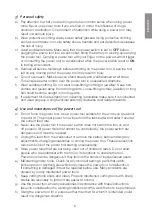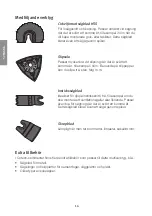
8
EN
GL
IS
H
Changing sanding sheets
The sanding sheets are attached with hook and loop fasteners. Remove the old
sanding sheet, brush off the hook and loop fabric on the sanding pad if necessary,
and then attach the new sanding sheet.
Starting the machine
1. Before connecting the multi-tool’s mains cable to a wall socket, make sure that
the ON/OFF switch is set to the
0
position (OFF).
2. Start the multi-tool by sliding the ON/OFF switch to the
I
position (ON).
Selecting the required speed
• The speed can be adjusted during use using the speed selector.
• The choice of speed depends on the type of work being carried out and the type
of material being worked on. Experiment until you find the best speed setting.
Cutting and sawing
Caution should be observed when using the saw blades. Check the working area so
that you are prepared for any nails, screws or anything else which could cause you to
lose control over the multi-tool. If you are cutting wall tiles, bear in mind that the tool
will be subjected to hard wear during prolonged use.
Sanding
• Always use undamaged sandpaper and change it often. This will not only give you
better results but also prolong the life of your multi-tool.
• Do not use excessive force when sanding, apply a constant, light pressure.
Applying too much pressure will not speed up the sanding process; it will merely
wear out the sandpaper and the multi-tool more quickly.
• When sanding wood, do not use sanding sheets which have previously been used
for metal.
Care and maintenance
• Always keep the motor’s ventilation openings free from dust and debris.
• Clean the multi-tool using a damp cloth. Use only mild cleaning agents, never
solvents or corrosive chemicals.
• If the mains lead is damaged it must only be replaced by a qualified electrician.









































